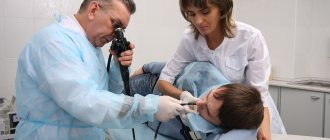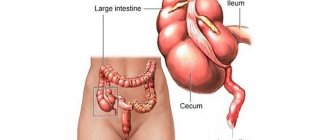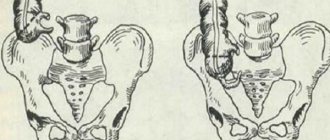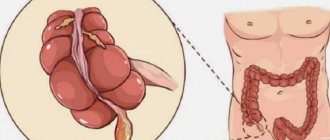A painful stomach occurs for various reasons. Intestinal upset and bloating can create pain in the abdominal area. However, the cause of the discomfort can also be a more serious reason - appendicitis. To distinguish it from other diseases, it is worth looking at the accompanying signs that appear.
Appendicitis is a disease of the appendage of the cecum, called the appendix. Inflammatory processes occurring inside the organ lead to its swelling and increase in size. In the absence of the necessary treatment, the disease passes from a simple stage to an acute form with subsequent complications.
Inflammation of the appendix can often be confused with a disorder of the digestive process. Therefore, it is important to know what symptoms indicate the development of appendicitis in order to call an ambulance before the onset of peritonitis.
Symptoms
Abdominal pain is often confused with an ailment of the digestive system, but there are distinctive signs that make it possible to recognize suspected inflammation:
- Pain syndrome in the abdominal area. Only at the beginning of the inflammatory process is discomfort felt near the navel, with a gradual movement to the right, to the lower corner, to where the appendix is located. The attack and pain occur unexpectedly, it is impossible to take a deep breath. The pain syndrome intensifies many times when a person begins to cough or laugh.
- Body position. When the appendix becomes inflamed, the human body involuntarily takes a certain position in which the pain is not so strong. A man walks in a bent position. In the supine position, both the adult and the child lie on their sides with their legs pulled up.
- Nausea, vomiting develops. The inflammatory processes occurring inside also affect the intestines, causing a feeling of nausea and regular vomiting, which does not bring relief. In rare cases, gagging occurs 1-2 times; the majority of patients complain of ongoing discomfort. Schoolchildren and teenagers suffer from appendicitis more often, which is why vomiting occurs more often during this period. Adults experience vomiting much less frequently. If the disease develops in an elderly person, such symptoms are not observed.
- Body temperature. When the body tries to cope with any inflammation, the overall temperature rises. As a rule, the thermometer shows 37.5 - 38 degrees. In a child’s body, the temperature can reach 40. An increase in thermometer readings indicates an increase in the inflammatory process and the progress of the disease.
- Defecation disorder. It is rare for an upset bowel symptom to occur. Only if the location of the appendix itself is atypical, then there may be a lack of stool or diarrhea. It is worth noting the state of a person after defecation is liquid. If after the process there is temporary relief, then there is poisoning; if there is no relief, it is appendicitis.
- Feeling of dry mouth and plaque. The appearance of these signs clearly indicates the development of inflammatory processes in the cecal appendage.
In rare cases, pain may occur when urinating. This occurs due to the location of the appendix next to the bladder and pressure on it (sometimes it is believed that the kidney hurts). Pain may appear in the lumbar spine or in the groin. It all depends on the specific position of the appendix in the human body. Sometimes it is difficult to diagnose the disease when children develop a runny nose and a cold cough.
Appendicitis in pregnant women
Appendicitis in pregnant women is a common occurrence that occurs during the second trimester of embryonic development. Pain during the pathological process of the patient is confused with the characteristic pain syndrome from constipation or fetal movements. Against the background of the inflammatory process, a woman’s heart rate increases, shortness of breath appears, and her temperature increases. Nausea and vomiting in this case are not specific signs of damage to the rectal appendage, because they may be signs of toxicosis.
The severity and localization of pain depend on the force of pressure of the uterus on the inflamed appendix. The longer the pregnancy, the more the uterine endometrium begins to put pressure on the appendix. As a result, the appendage of the cecum begins to rise upward, changing the location of the pain.
This increases the risk of premature birth, intestinal failure, placental abruption and peritonitis. Therefore, if appendicitis is suspected, a woman should immediately consult a doctor in order to protect her life and ensure the normal embryonic development of the unborn child.
Instructions for determination in an adult
The procedure must involve two people; it is difficult to independently determine the disease. It is possible to determine appendicitis at home using the following methods:
- Take a horizontal position. It is permissible to lie on a bed or on the floor, as long as the surface is level. Hands fall along the body. Spread your legs slightly to the sides, try to bend them. When bending the legs, the other person presses on the lower right corner of the abdomen and sharply removes their hands. At the moment of removal, pain should flare up - the help of a doctor is required, this is appendicitis. Perhaps the pain syndrome will be in the genital area, on the left or near the navel.
- Lying on the floor, arms extended along the body, legs straight. You need to raise your right leg to 50 degrees. The assistant should hit the heel of the outstretched leg with the edge of his palm. Repeat the same procedure with the left leg. The manifestation of pain on the right side indicates appendicitis.
- Self-diagnosis of appendicitis is possible by coughing. The pain intensifies and responds in the right side.
- Walking is considered an important sign of the ongoing inflammatory process. Each step will begin to respond with pain and discomfort localized on the right.
- When performing independent palpation of the peritoneum, it is possible to feel tense muscles and a hard appendix, which indicates the development of the disease. In a healthy person, when palpated, the muscles are relaxed, the abdomen is soft, without pain.
Home test for appendicitis
Doctors recommend doing a small test for appendicitis at home:
- The patient lies on his right side. Movements must be performed carefully so as not to cause mechanical damage.
- Then the person assumes the fetal position: the bent legs are gradually pulled towards the chest.
- Find out the patient's feelings. If the pain subsides, it means appendicitis.
- The patient remains in this position for about three minutes.
- Afterwards, the person needs to turn on his left side and stretch his legs.
- Find out the feelings in this position. A sharp increase in the discomfort makes it possible to recognize the development of the inflammatory process in the appendix.
Differences between symptoms in a child and during pregnancy
When the appendix is inflamed in a pregnant woman, the pain syndrome is slightly shifted to the side. During fetal growth, all internal organs have undergone a change in location. Discomfort during pregnancy is higher.
A child cannot always say that his stomach hurts, show where it hurts and describe correctly the nature of the pain. Adults need to self-check and find out the severity of symptoms. If a child constantly squats, there is frequent crying for no apparent reason - this indicates inflammation of the appendage. Sometimes there is also bloating and regular vomiting. An additional sign of the development of an inflammatory process in a child’s body is refusal to eat and a lethargic state.
Identifying inflammation is a priority task, but it is worth pointing out what absolutely cannot be done if self-diagnosis has confirmed appendicitis:
- You should not wait for complications to develop when a temperature appears accompanied by abdominal pain. You should seek immediate medical attention.
- It is strictly forbidden to take any painkillers or laxatives. Taking them blurs the manifestation of symptoms and does not allow for a correct diagnosis, which means timely provision of qualified assistance.
- You should also stop taking stomach medications or bowel medications. The chemical compounds they contain can react with the contents of the inflamed appendix, which will lead to its rupture and the development of peritonitis, which is often fatal.
- It is not advisable to eat or drink until the ambulance arrives. The only treatment for appendicitis is surgery, i.e. The inflamed appendage will be removed. The stomach and intestines should be free of food debris. Digestion of food is accompanied by irritation of the walls of the intestinal tract, which leads to increased pain.
Inflammation of the appendix in children
Appendicitis in infants and preschool children is difficult to detect. During such a period, internal organs and systems continue to form. The growth of bones and soft tissues leads to a change in the initial location of the intestinal appendix. It is difficult for a child to talk about his feelings. He is experiencing severe stress, not understanding what is happening to him and how to report it. Parents should not ignore the child's constant crying and complaints of pain.
Despite accelerated regeneration, children have a more difficult time withstanding operations and infectious diseases. Therefore, it is important to take your child to the doctor. An inpatient pediatrician will help identify the cause of symptoms and prescribe appropriate treatment.
It is important to remember that children do not like to be left alone in hospitals. Because of this, they often lie about feeling normal and may endure severe pain. In such cases, the child cannot be trusted, because appendicitis poses a threat to his life.
Diagnostics in the hospital
The doctor’s actions: conduct an examination, palpate the area of pain, tests and instrumental examination.
Analyzes
After delivering the patient, doctors will need a urine and blood test. As a rule, tests are taken in the hospital to rule out other potential diseases that cause similar symptoms.
Ultrasound
The condition of the abdominal area is checked using an ultrasound. Carrying out ultrasound analysis makes it possible to accurately determine the occurrence of inflammatory processes inside the human body. With the help of the examination, the location of the organ is determined.
Acute appendicitis in elderly people
Appendicitis in old age is more difficult to diagnose. This phenomenon is due to the natural aging processes in the body - after 50 years, the pain threshold increases, so patients do not pay attention to the discomfort and tolerable pain in the lower right part of the abdomen.
There is a feature of an attack of inflammation, which manifests itself in the form of a small tumor at the location of the appendix. Swelling develops after 2-3 days of constant pain.
Body temperature practically does not increase, but nausea and vomiting are observed more often than in patients from 20 to 50 years old. Diarrhea or constipation are typical for older people, so patients do not complain about stool retention or changes in stool. Therefore, in 15-35% of cases, doctors may make an incorrect diagnosis.
Results
Appendicitis usually occurs acutely, with the risk of purulent complications in the abdominal cavity. Characteristic symptoms:
- sharp pain in the right iliac region;
- nausea, stool upset, vomiting;
- hyperthermia;
Specific signs of appendicitis in men in a full description of symptoms are:
- radiating pain in the pubis and penis;
- elevation of the right testicle and its pain when pulling the scrotum by the base.
Appendicitis can only be treated surgically.
The inflamed appendix is removed during laparotomy or laparoscopic surgery. [Total: 3 Average: 5/5]
Treatment of chronic appendicitis
If clinical manifestations are not too obvious and there is no infiltrate, dropsy or mucocele, conservative treatment can be prescribed. They recommend antibiotics, antispasmodics, drugs that normalize gastrointestinal motility (prokinetics), and physiotherapeutic procedures that help resolve the inflammatory process.
If the symptoms of the disease cause severe discomfort to the patient, and pathological changes in the appendix are obvious, surgery is necessary. Appendectomy can be done either openly or endoscopically, depending on the technical equipment of the medical institution. After surgery, gastroprotectors (rebamipide) are prescribed to help restore the intestinal mucosa.
Why does the appendix become inflamed?
The vermiform appendix of the cecum is a vestigial appendage . It is a narrow tube from 5 to 15 cm long, which has its own mesentery, which provides mobility to the process. One end of it communicates with the cavity of the cecum, and the other ends blindly.
The causative agent of the inflammatory process in the appendix is a number of microorganisms that penetrate the mucous membrane of the wall from the lumen of the organ. These can be staphylococci, streptococci, anaerobes, E. coli.
Causes
The specific cause that leads to inflammation in the appendix is difficult to determine. There are a number of circumstances that contribute to the emergence of this process.
Inflammation of the appendix can be caused by the following factors::
- congestion in the organ due to the presence of foreign bodies, fecal stones in its lumen;
- bending of the process, leading to disruption of blood flow in its wall, which contributes to a decrease in local immunity and active proliferation of bacterial flora;
- eating disorders with frequent consumption of protein foods;
- various helminthiases;
- tumors of the cecum;
- chronic constipation.
Any of these reasons can serve as an impetus for the development of appendicitis in men , especially with frequent infectious diseases against the background of weakened body defenses and problems with the gastrointestinal tract. This category of the male population is at risk for developing inflammation of the appendix and requires a more attentive attitude to their health.
Interesting on the topic:
Possible complications of acute appendicitis
What is the catarrhal stage of appendicitis?
Which doctor should I contact if I have appendicitis?
Appendicitis: causes
Main reasons:
- Blockage of the appendix with food debris.
- Congenital abnormalities of the appendix.
- Helminths.
- Infectious diseases in which ulcers form on the mucous membrane of the organ.
- Inflammatory bowel diseases.
- Ingestion of foreign bodies and food waste.
Doctors believe that chronic inflammatory processes (caries, adenoids, sore throat) lead to inflammation of the appendix.
Seek medical help at the first symptoms
Stages of development
Appendicitis develops quickly and in stages:
- The appendage swells.
- The cavity fills with pus.
- Within 3 days without surgery, the appendage ruptures.
- Purulent contents fill the abdominal cavity.
- Peritonitis develops, and the patient's condition becomes critical.
How many days can an adult suffer from appendicitis? The pain from acute inflammation lasts for several days, after which tissue necrosis occurs. At this stage of inflammation, a person dies without surgery.
For adults, the optimal time to seek help is the first 12 hours from the onset of symptoms. The child needs help after 3–4 hours.










